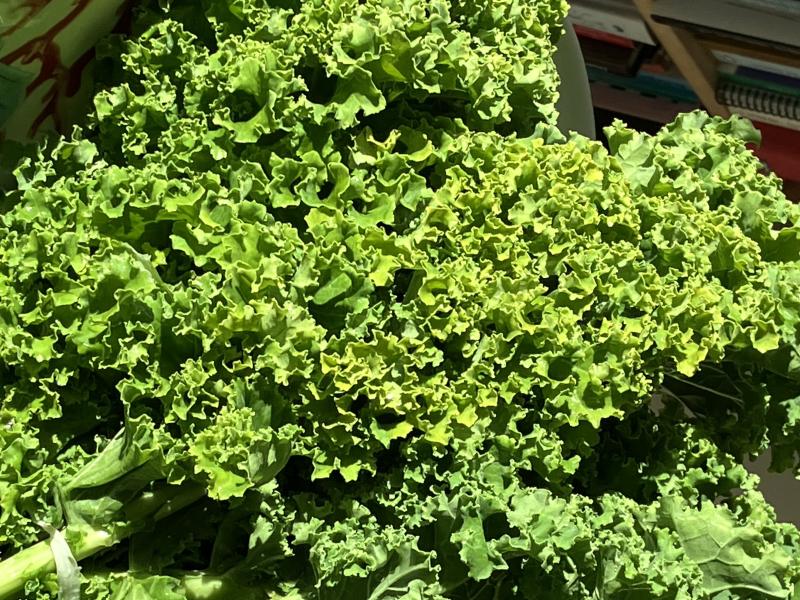Kale comes into its own with cool fall weather
If you’re shopping at a farmers market or neighborhood grocery this time of year, you will be sure to find an ample supply of kale. With its signature ruffled leaves, this pretty green vegetable is a cool-weather staple that shares a common ancestor with cabbage. The key difference between the two is the loose-leaf form of kale as compared to the tightly packed leaves in heads of cabbage.
One of the questions that has puzzled me is why there was a sudden burst of interest in this ancient green. I first wrote about kale in this column more than 10 years ago when it emerged as the healthy-choice darling on the menus of celebrities, farm-to-table chefs and hipsters alike. Previously, the largest consumer of kale was reported to be the Pizza Hut restaurant chain, where kale was used as decoration on the salad bar.
Food and health analyst Eve Turow researched this very subject for the website mindbodygreen.com, reporting that this 2,000-year old vegetable was made famous through public relations guru Oberon Sinclair. According to Turow, the extent of efforts to make kale mainstream included Sinclair’s references to a nonexistent affinity group called the American Kale Association.
What is all the hype about? Kale is considered a nutritional powerhouse, loaded with vitamins, minerals, micronutrients and fiber. It’s one of the few green vegetables available in autumn and winter, and the taste of kale is actually better after frost mellows its bitterness. The name comes from the Scottish word kail, which means both a type of cabbage and a dish made from cabbage.
In Scotland, a small kitchen garden located next to a cottage was known as a kailyard. During the 19th century, the “kailyard school” of Scottish writers was distinguished by their unrealistically sentimental portrayals of rural life. In northern regions of Germany and parts of Scandinavia, kale is the focus of a festival called Grünkohlessen. To celebrate the autumn harvest of kale, communities organize scenic walks through the brisk cold to a designated local pub where they crown the cabbage king.
The primary varieties of kale found today are green kale (see photo) and lacinato kale, which has long, slender leaves with ruffled edges off a sturdy stem. Because of the leaves’ dark color, shape and bumpy texture, it is also known as dinosaur kale, flat-back kale and palm tree kale. This variety was reported to have been grown in the gardens of Thomas Jefferson at Monticello.
Primary uses of kale include tossing chopped leaves into salads, steaming or grilling leaves with lemon zest garnish, or baking semi-healthy kale chips, better suited for the lacinato leaves. I’ve included a recipe for chips, which are somewhat labor intensive, as they turn out best when the leaves are hand-rubbed with olive oil. Soups and stews are enhanced by the addition of kale leaves, which pair well with beans such as garbanzo or cannellini. This soup is easy to assemble and can be adapted to whatever ingredients you may have on hand. Feel free to substitute different beans and adjust the herbs to use your favorites. Although the braised kale recipe specifies lacinato kale, it works just as well with green kale. All hail kale!
Kale Chips
Preheat oven to 300 F. Line baking sheet with parchment paper; set aside. Wash and completely dry the kale leaves. Trim out the tough center stem and tear the leaves into bite-size pieces. Spread the olive oil on a piece of waxed paper. Toss the leaves onto the oil. Using your hands, gently rub the oil into the leaves. Places the leaves in a single layer on the prepared baking sheet. Sprinkle with salt, to taste. Bake until crisp but not browned, about 20 minutes.
Braised Kale
Rinse the kale leaves; cut in half lengthwise, discarding any woody stems or ends. Heat olive oil in a dutch oven over medium. Stir in the garlic, heating until fragrant, about 2 minutes. Add the cherry tomatoes, lemon juice and zest. Stir occasionally until the cherry tomatoes begin to break down slightly, about 3 to 5 minutes. Add the kale and 1/4 C water. Cover the pot and let the kale braise for 15 minutes, stirring once or twice. Check the water level and add remaining 1/4 C water, if needed. When leaves are tender, stir in butter. Season to taste with salt and pepper. Yield: 4 servings.
Kale & Cannellini Bean Soup
Heat olive oil in a large saucepan over medium heat. Sauté the onion until it starts to brown. Stir in the garlic and cook until fragrant, about a minute. Add broth, tomatoes, undrained beans, kale, basil, oregano, tarragon and parsley. Stir to combine and toss in cheese rind. Bring to a boil, then reduce heat to low. Cover and simmer for 15 minutes. Remove the cheese rind, and use an immersion blender to puree the soup until creamy. Adjust seasonings and serve garnished with grated Parmesan cheese. Yield: 4 servings.
















































